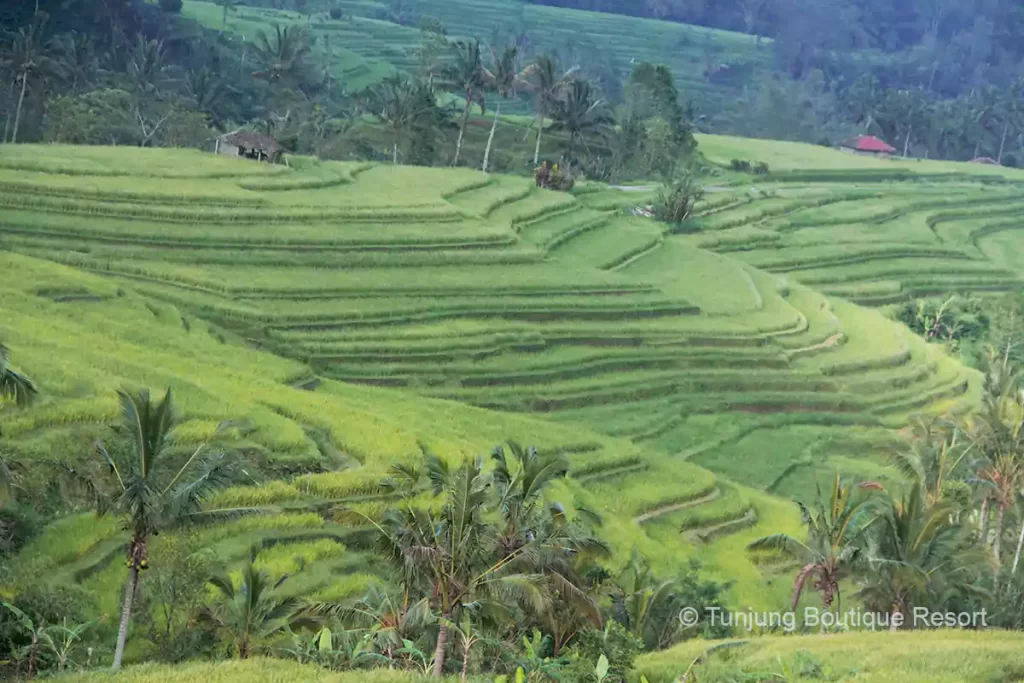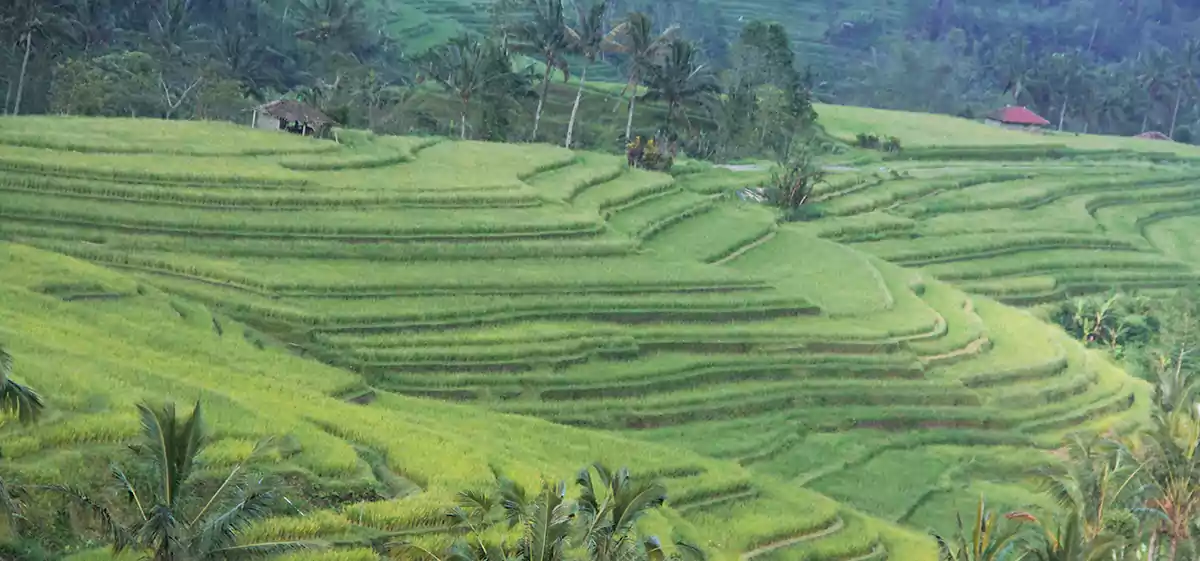Jatiluwih Rice Terrace is a breathtaking Bali UNESCO World Heritage site in the Tabanan Regency. It is renowned for its stunning panoramic views of terraced rice fields. And also showcases the traditional and sustainable Subak irrigation system practiced by Balinese farmers for centuries.
The name “Jatiluwih” is derived from the Jati and Luwih words in the Balinese language. “Jati” means “real” or “true,” while “Luwih” means “beautiful” or “excellent.” Together, they signify the exceptional beauty and authenticity of the rice terraces.
Spanning over 600 hectares (1,480 acres) of land, the Jatiluwih Rice Terrace offers a mesmerizing landscape of cascading rice terraces. And also includes lush green fields and palm trees against the backdrop of Mount Batukaru. The rice terraces follow the contours of the mountain slopes, creating a visually stunning and harmonious agricultural landscape.
The Subak irrigation system is the traditional method farmers use to manage water flow and distribute it evenly across the rice fields. It is a cooperative system where farmers work together to ensure the proper water supply for cultivation. This sustainable and communal approach to agriculture has not only preserved the beauty of the Jatiluwih Rice Terrace. But, it also reflects the Balinese people’s cultural significance and close relationship with their land.

Famous Tourist Destination in Tabanan Bali
Jatiluwih is one the famous tourist destinations in Tabanan Bali. It is on the west of the island, offering the rice terrace’s beautiful scenery with a fresh atmosphere surrounding it. It is equal to its name, which means good or beautiful. Moreover, you will discover the breathtaking panorama of the rice terrace with Mount Batukaru as a backdrop.
UNESCO has appointed Jatiluwih Rice Terrace as a World Heritage Site, notably by Subak Organization, as a fundamental of the local society life. The farmer plants the varieties of local rice in this area. It is mainly with the size of rice trees is relatively higher than the usual rice grown in other regions of Bali. Jatiluwih is also famous as an area with organic agriculture.
Visitors to Jatiluwih can explore the rice terraces on foot or by cycling through the scenic pathways. The placement of several observation points and viewpoints is the strategy to allow visitors to admire and photograph the captivating landscapes. The expansive area provides ample opportunities for nature walks, photography, and immersing oneself in the serene rural atmosphere.
This site is ideal for those who want to learn more about traditional Balinese agriculture. The local guides can provide insights into the Subak irrigation system, rice cultivation techniques, and the cultural significance of the rice terraces.
Jatiluwih Rice Terrace is a visual spectacle and a cultural and educational experience. It offers a glimpse into sustainable farming practices and the harmonious coexistence between nature and humans in Bali. It is an excellent destination for nature lovers, photographers, and those seeking a peaceful retreat amidst the beauty of Bali’s countryside.

Popular Tourist Attraction that You Never Missed
The government has set the Jatiluwih as a rural tourist attraction in line with tracking more visitors. Therefore, they continuously improve and develop it. Jatiluwih also keeps the unique religious ceremony, especially when the temple ceremony at Petani temple on Wednesday Kliwon Ugu ( Balinese calendar). The local Balinese believe that the Petani Temple is a center to worship God in manifestation as an agricultural sovereign.
Meanwhile, public facilities include a parking area, toilet, Bale Bengong for resting, and restaurants are also available. The restaurants in this area provide a variety of menus, especially Indonesian food, and some drinks.
Best Time to Visit Jatiluwih Rice Terrace
The best time to visit Jatiluwih Rice Terrace is during the dry season, typically from April to October. During this period, the weather is generally sunny, with less rainfall and lower humidity. It will provide the ideal conditions for exploring the rice terraces.
Visiting Jatiluwih during the dry season allows you to witness the vibrant green hues of the rice fields in their full glory. The terrace landscapes are at their most picturesque, and the clear skies enhance the overall beauty of the area. Additionally, the dry season corresponds with Bali’s peak tourist season is the best time. So, you can expect the rice terraces to be well-maintained and easily accessible.
It’s worth noting that even during the dry season, Bali’s weather can be unpredictable, and occasional rain showers may occur. It’s always a good idea to check the weather forecast before your visit and be prepared for potential changes in weather conditions.
If you prefer to avoid crowds, consider visiting Jatiluwih during the shoulder months of April, May, September, or October. These months are slightly less busy than the peak tourist season, allowing for a more tranquil and immersive experience amidst the rice terraces.
Overall, the beauty of Jatiluwih Rice Terrace can be perfect year-round. But, the dry season offers the best chances for clear weather and optimal viewing conditions.



